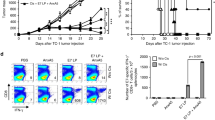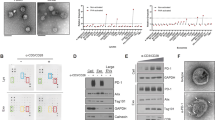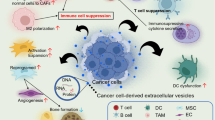Abstract
Cancer cells aberrantly express immunosuppressive checkpoint ligands and produce certain metabolites that lead to T cell exhaustion. Immune checkpoint blockade (ICB) therapy that reinvigorates exhausted T cells have achieved impressive response in clinical cancer treatment. However, the limited clinical response rate and off-tumor toxicities restrict ICB therapy. Herein, cellular vesicles displaying anti-programmed cell death-1 (PD-1) single-chain variable fragment antibody (aPD-1-scFv) were prepared to reinvigorate T cell immunity to counteract cancer. The nanovesicles displaying aPD-1-scFv (aPD-1-scFv NVs) could enhance the anti-tumor activation of T cells through PD-1 blockade. Furthermore, NVs loading the A2a adenosine receptor (A2aR) antagonist CPI-444 assisted T cells to antagonize adenosine, an immunosuppressive metabolite produced by cancer cells. Hence, CPI-444 loaded aPD-1-scFv NVs could intensively increase the density and activity of tumor infiltrating T cells, directly restraining tumor progress and metastasis.

Similar content being viewed by others
References
Sharpe, A. H.; Wherry, E. J.; Ahmed, R.; Freeman, G. J. The function of programmed cell death 1 and its ligands in regulating autoimmunity and infection. Nat. Immunol. 2007, 8, 239–245.
Keir, M. E.; Butte, M. J.; Freeman, G. J.; Sharpe, A. H. Pd-1 and its ligands in tolerance and immunity. Annu. Rev. Immunol. 2008, 26, 677–704.
Sun, C.; Mezzadra, R.; Schumacher, T. N. Regulation and function of the PD-L1 checkpoint. Immunity 2018, 48, 434–452.
Sanmamed, M. F.; Chen, L. A paradigm shift in cancer immunotherapy: From enhancement to normalization. Cell 2018, 175, 313–326.
Ganesh, K.; Stadler, Z. K.; Cercek, A.; Mendelsohn, R. B.; Shia, J.; Segal, N. H.; Diaz, L. A. Jr. Immunotherapy in colorectal cancer: Rationale, challenges and potential. Nat. Rev. Gastroenterol. Hepatol. 2019, 16, 361–375.
Schadendorf, D.; Fisher, D. E.; Garbe, C.; Gershenwald, J. E.; Grob, J. J.; Halpern, A.; Herlyn, M.; Marchetti, M. A.; McArthur, G.; Ribas, A. et al. Melanoma. Nat. Rev. Dis. Primers 2015, 1, 15003.
Preusser, M.; Lim, M.; Hafler, D. A.; Reardon, D. A.; Sampson, J. H. Prospects of immune checkpoint modulators in the treatment of glioblastoma. Nat. Rev. Neurol. 2015, 11, 504–514.
O’Donnell, J. S.; Teng, M. W. L.; Smyth, M. J. Cancer immunoediting and resistance to T cell-based immunotherapy. Nat. Rev. Clin. Oncol. 2019, 16, 151–167.
Kalbasi, A.; Ribas, A. Tumour-intrinsic resistance to immune checkpoint blockade. Nat. Rev. Immunol. 2020, 20, 25–39.
Binnewies, M.; Roberts, E. W.; Kersten, K.; Chan, V.; Fearon, D. F.; Merad, M.; Coussens, L. M.; Gabrilovich, D. I.; Ostrand-Rosenberg, S.; Hedrick, C. C. et al. Understanding the tumor immune microenvironment (time) for effective therapy. Nat. Med. 2018, 24, 541–550.
Chen, Q. J.; Liu, L. S.; Lu, Y. F.; Chen, X. L.; Zhang, Y. J.; Zhou, W. X.; Guo, Q.; Li, C.; Zhang, Y. W.; Zhang, Y. et al. Tumor microenvironment-triggered aggregated magnetic nanoparticles for reinforced image-guided immunogenic chemotherapy. Adv. Sci. 2019, 6, 1802134.
Togashi, Y.; Shitara, K.; Nishikawa, H. Regulatory T cells in cancer immunosuppression—implications for anticancer therapy. Nat. Rev. Clin. Oncol. 2019, 16, 356–371.
Mantovani, A.; Marchesi, F.; Malesci, A.; Laghi, L.; Allavena, P. Tumour-associated macrophages as treatment targets in oncology. Nat. Rev. Clin. Oncol. 2017, 14, 399–416.
Gabrilovich, D. I.; Nagaraj, S. Myeloid-derived suppressor cells as regulators of the immune system. Nat. Rev. Immunol. 2009, 9, 162–174.
Vijayan, D.; Young, A.; Teng, M. W. L.; Smyth, M. J. Targeting immunosuppressive adenosine in cancer. Nat. Rev. Cancer 2017, 17, 709–724.
Decking, U. K. M.; Schlieper, G.; Kroll, K.; Schrader, J. Hypoxia-induced inhibition of adenosine kinase potentiates cardiac adenosine release. Circ. Res. 1997, 81, 154–164.
Willingham, S. B.; Ho, P. Y.; Hotson, A.; Hill, C.; Piccione, E. C.; Hsieh, J.; Liu, L.; Buggy, J. J.; McCaffery, I.; Miller, R. A. A2AR antagonism with CPI-444 induces antitumor responses and augments efficacy to anti-PD-(L)1 and anti-CTLA-4 in preclinical models. Cancer Immunol. Res. 2018, 6, 1136–1149.
Ma, S. R.; Deng, W. W.; Liu, J. F.; Mao, L.; Yu, G. T.; Bu, L. L.; Kulkarni, A. B.; Zhang, W. F.; Sun, Z. J. Blockade of adenosine A2A receptor enhances CD8+ T cells response and decreases regulatory T cells in head and neck squamous cell carcinoma. Mol. Cancer 2017, 16, 99.
Yang, J. X.; Wang, C. H.; Shi, S.; Dong, C. Y. Nanotechnologies for enhancing cancer immunotherapy. Nano Res. 2020, 13, 2595–2616.
Ramos-Casals, M.; Brahmer, J. R.; Callahan, M. K.; Flores-Chávez, A.; Keegan, N.; Khamashta, M. A.; Lambotte, O.; Mariette, X.; Prat, A.; Suárez-Almazor, M. E. Immune-related adverse events of checkpoint inhibitors. Nat. Rev. Dis. Primers 2020, 6, 38.
Khoja, L.; Day, D.; Chen, T. W. W.; Siu, L. L.; Hansen, A. R. Tumour- and class-specific patterns of immune-related adverse events of immune checkpoint inhibitors: A systematic review. Ann. Oncol. 2017, 28, 2377–2385.
Topalian, S. L.; Taube, J. M.; Anders, R. A.; Pardoll, D. M. Mechanism-driven biomarkers to guide immune checkpoint blockade in cancer therapy. Nat. Rev. Cancer 2016, 16, 275–287.
Postow, M. A.; Sidlow, R.; Hellmann, M. D. Immune-related adverse events associated with immune checkpoint blockade. N. Engl. J. Med. 2018, 378, 158–168.
Adams, J. L.; Smothers, J.; Srinivasan, R.; Hoos, A. Big opportunities for small molecules in immuno-oncology. Nat. Rev. Drug Discov. 2015, 14, 603–622.
Osipov, A.; Saung, M. T.; Zheng, L.; Murphy, A. G. Small molecule immunomodulation: The tumor microenvironment and overcoming immune escape. J. Immunother. Cancer 2019, 7, 224.
Yang, X.; Gao, L.; Guo, Q.; Li, Y. J.; Ma, Y.; Yang, J.; Gong, C. Y.; Yi, C. Nanomaterials for radiotherapeutics-based multimodal synergistic cancer therapy. Nano Res. 2020, 13, 2579–2594.
Li, J. Y.; Mooney, D. J. Designing hydrogels for controlled drug delivery. Nat. Rev. Mater. 2016, 1, 16071.
Suthiwangcharoen, N.; Li, T.; Li, K.; Thompson, P.; You, S. J.; Wang, Q. M13 bacteriophage-polymer nanoassemblies as drug delivery vehicles. Nano Res. 2011, 4, 483–493.
Ingato, D.; Edson, J. A.; Zakharian, M.; Kwon, Y. J. Cancer cell-derived, drug-loaded nanovesicles induced by sulfhydryl-blocking for effective and safe cancer therapy. ACS Nano 2018, 12, 9568–9577.
Wang, H. J.; Bremner, D. H.; Wu, K. H.; Gong, X. R.; Fan, Q.; Xie, X. T.; Zhang, H. M.; Wu, J. Z.; Zhu, L. M. Platelet membrane biomimetic bufalin-loaded hollow MnO2 nanoparticles for MRI-guided chemo-chemodynamic combined therapy of cancer. Chem. Eng. J. 2020, 382, 122848.
El Andaloussi, S.; Mäger, I.; Breakefield, X. O.; Wood, M. J. A. Extracellular vesicles: Biology and emerging therapeutic opportunities. Nat. Rev. Drug Discov. 2013, 12, 347–357.
Liu, C.; Feng, Q.; Sun, J. S. Lipid nanovesicles by microfluidics: Manipulation, synthesis, and drug delivery. Adv. Mater. 2019, 31, 1804788.
Xie, F.; Zhou, X. X.; Fang, M. Y.; Li, H. Y.; Tu, Y. F.; Zhang, L.; Zhou, F. F. Extracellular vesicles in cancer immune microenvironment and cancer immunotherapy. Adv. Sci. 2019, 6, 1901779.
Wang, X. Y.; Lu, Z. G.; Zhang, J. M.; Zhao, B. C.; Wang, J. Z.; Shen, J.; Niu, Y. W.; Xiao, Z. B.; Liu, G. Y.; Hao, J. F. et al. Cationic nano-fragrance with sustained release property for neuroregulation. J. Biomed. Nanotechnol. 2020, 16, 344–351.
Lu, M.; Huang, Y. Y. Bioinspired exosome-like therapeutics and delivery nanoplatforms. Biomaterials 2020, 242, 119925.
Zhang, X. D.; Wang, C.; Wang, J. Q.; Hu, Q. Y.; Langworthy, B.; Ye, Y. Q.; Sun, W. J.; Lin, J.; Wang, T. F.; Fine, J. et al. PD-1 blockade cellular vesicles for cancer immunotherapy. Adv. Mater. 2018, 30, 1707112.
Théry, C.; Ostrowski, M.; Segura, E. Membrane vesicles as conveyors of immune responses. Nat. Rev. Immunol. 2009, 9, 581–593.
Lv, P.; Liu, X.; Chen, X. M.; Liu, C.; Zhang, Y.; Chu, C. C.; Wang, J. Q.; Wang, X. Y.; Chen, X. Y.; Liu, G. Genetically engineered cell membrane nanovesicles for oncolytic adenovirus delivery: A versatile platform for cancer virotherapy. Nano Lett. 2019, 19, 2993–3001.
Zhang, P. F.; Liu, G.; Chen, X. Y. Nanobiotechnology: Cell membrane-based delivery systems. Nano Today 2017, 13, 7–9.
Jang, S. C.; Kim, O. Y.; Yoon, C. M.; Choi, D. S.; Roh, T. Y.; Park, J.; Nilsson, J.; Lötvall, J.; Kim, Y. K.; Gho, Y. S. Bioinspired exosome-mimetic nanovesicles for targeted delivery of chemotherapeutics to malignant tumors. ACS Nano 2013, 7, 7698–7710.
Zhang, P. F.; Zhang, L.; Qin, Z. N.; Hua, S. H.; Guo, Z. D.; Chu, C. C.; Lin, H. R.; Zhang, Y.; Li, W. G.; Zhang, X. Z. et al. Genetically engineered liposome-like nanovesicles as active targeted transport platform. Adv. Mater. 2018, 30, 1705350.
Liu, X.; Liu, C.; Zheng, Z. Z.; Chen, S. Y.; Pang, X.; Xiang, X. C.; Tang, J. X.; Ren, E.; Chen, Y. Z.; You, M. et al. Vesicular antibodies: A bioactive multifunctional combination platform for targeted therapeutic delivery and cancer immunotherapy. Adv. Mater. 2019, 31, 1808294.
Li, L. Y.; Miao, Q. W.; Meng, F. Q.; Li, B. Q.; Xue, T. Y.; Fang, T. L.; Zhang, Z. R.; Zhang, J. X.; Ye, X. Y.; Kang, Y. et al. Genetic engineering cellular vesicles expressing CD64 as checkpoint antibody carrier for cancer immunotherapy. Theranostics 2021, 11, 6033–6043.
Zhang, X. D.; Kang, Y.; Wang, J. Q.; Yan, J. J.; Chen, Q.; Cheng, H.; Huang, P.; Gu, Z. Engineered PD-Ll-expressing platelets reverse new-onset type 1 diabetes. Adv. Mater. 2020, 32, 1907692.
Tee, J. K.; Yip, L. X.; Tan, E. S.; Santitewagun, S.; Prasath, A.; Ke, P. C.; Ho, H. K.; Leong, D. T. Nanoparticles’ interactions with vasculature in diseases. Chem. Soc. Rev. 2019, 48, 5381–5407.
Thommen, D. S.; Schumacher, T. N. T cell dysfunction in cancer. Cancer Cell 2018, 33, 547–562.
Anderson, K. G.; Stromnes, I. M.; Greenberg, P. D. Obstacles posed by the tumor microenvironment to T cell activity: A case for synergistic therapies. Cancer Cell 2017, 31, 311–325.
Chen, D. S.; Mellman, I. Elements of cancer immunity and the cancer-immune set point. Nature 2017, 541, 321–330.
Wei, S. C.; Duffy, C. R.; Allison, J. P. Fundamental mechanisms of immune checkpoint blockade therapy. Cancer Discov. 2018, 8, 1069–1086.
Daillère, R.; Vétizou, M.; Waldschmitt, N.; Yamazaki, T.; Isnard, C.; Poirier-Colame, V.; Duong, C. P. M.; Flament, C.; Lepage, P.; Roberti, M. P. et al. Enterococcus hirae and Barnesiella intestinihominis facilitate cyclophosphamide-induced therapeutic immunomodulatory effects. Immunity 2016, 45, 931–943.
Davis, D. M. Intercellular transfer of cell-surface proteins is common and can affect many stages of an immune response. Nat. Rev. Immunol. 2007, 7, 238–243.
Zhao, P.; Wang, P.; Dong, S. Y.; Zhou, Z. M.; Cao, Y. G.; Yagita, H.; He, X.; Zheng, S. G.; Fisher, S. J.; Fujinami, R. S. et al. Depletion of PD-1-positive cells ameliorates autoimmune disease. Nat. Biomed. Eng. 2019, 3, 292–305.
Rafiq, S.; Yeku, O. O.; Jackson, H. J.; Purdon, T. J.; Van Leeuwen, D. G.; Drakes, D. J.; Song, M.; Miele, M. M.; Li, Z. N.; Wang, P. et al. Targeted delivery of a PD-1-blocking scFV by CAR-T cells enhances anti-tumor efficacy in vivo. Nat. Biotechnol. 2018, 36, 847–856.
Noy, R.; Pollard, J. W. Tumor-associated macrophages: From mechanisms to therapy. Immunity 2014, 41, 49–61.
Qian, B. Z.; Li, J. F.; Zhang, H.; Kitamura, T.; Zhang, J. H.; Campion, L. R.; Kaiser, E. A.; Snyder, L. A.; Pollard, J. W. CCL2 recruits inflammatory monocytes to facilitate breast-tumour metastasis. Nature 2011, 475, 222–225.
Xia, Y. Q.; Rao, L.; Yao, H. M.; Wang, Z. L.; Ning, P. B.; Chen, X. Y. Engineering macrophages for cancer immunotherapy and drug delivery. Adv. Mater. 2020, 32, 2002054.
Xiao, T. T.; Hu, W.; Fan, Y.; Shen, M. W.; Shi, X. Y. Macrophage-mediated tumor homing of hyaluronic acid nanogels loaded with polypyrrole and anticancer drug for targeted combinational photothermo-chemotherapy. Theranostics 2021, 11, 7057–7071.
McLane, L. M.; Abdel-Hakeem, M. S.; Wherry, E. J. CD8 T cell exhaustion during chronic viral infection and cancer. Annu. Rev. Immunol. 2019, 37, 457–495.
Farhood, B.; Najafi, M.; Mortezaee, K. CD8+ cytotoxic T lymphocytes in cancer immunotherapy: A review. J. Cell. Phys. 2019, 234, 8509–8521.
Watts, T. H. TNF/TNFR family members in costimulation of T cell responses. Annu. Rev. Immunol. 2005, 23, 23–68.
Croft, M. Co-stimulatory members of the TNFR family: Keys to effective t-cell immunity? Nat. Rev. Immunol. 2003, 3, 609–620.
Croft, M. The role of TNF superfamily members in T-cell function and diseases. Nat. Rev. Immunol. 2009, 9, 271–285.
Russell, J. H.; Ley, T. J. Lymphocyte-mediated cytotoxicity. Annu. Rev. Immunol. 2002, 20, 323–370.
Voskoboinik, I.; Whisstock, J. C.; Trapani, J. A. Perforin and granzymes: Function, dysfunction and human pathology. Nat. Rev. Immunol. 2015, 15, 388–400.
Sitkovsky, M. V. Lessons from the A2A adenosine receptor antagonist-enabled tumor regression and survival in patients with treatment-refractory renal cell cancer. Cancer Discov. 2020, 10, 16–19.
Leone, R. D.; Sun, I. M.; Oh, M. H.; Sun, I. H.; Wen, J. Y.; Englert, J.; Powell, J. D. Inhibition of the adenosine A2a receptor modulates expression of T cell coinhibitory receptors and improves effector function for enhanced checkpoint blockade and ACT in murine cancer models. Cancer Immunol., Immunother. 2018, 67, 1271–1284.
Acknowledgements
This work was supported by grants from the National Natural Science Foundation of China (No. 31971268), the Natural Science Foundation of Guangdong Province (No. 2020A1515010802), Guangdong Basic and Applied Basic Research Foundation (No. 2020A1515110166), Shenzhen Excellent Science and Technology Innovation Talent Training Project (Excellent Youth Project, No. RCYX20200714114643121), Science, Technology & Innovation Commission of Shenzhen Municipality (No. JCYJ20200109142610136), Basic Research Program of Shenzhen (No. JCYJ20180507181654186), Health System Scientific Research Project of Shenzhen Guangming District Science and Innovation Bureau (Nos. 2020R01073, and 2020R01061), Special Fund for Economic Development of Guangming District, Shenzhen (No. 2021R01128), University of Chinese Academy of Sciences—Shenzhen Hospital Research Funding (No. HRF-2020004), the Fundamental Research Funds for the Central Universities (No. 19lgzd45), Disciplinary Construction of Posts of Zhujiang Scholars (No. 4SG21005G), and Discipline Construction Project of Guangdong Medical University (No. 4SG21008G).
Author information
Authors and Affiliations
Corresponding authors
Electronic Supplementary Material
Rights and permissions
About this article
Cite this article
Xue, T., Zhang, Z., Fang, T. et al. Cellular vesicles expressing PD-1-blocking scFv reinvigorate T cell immunity against cancer. Nano Res. 15, 5295–5304 (2022). https://doi.org/10.1007/s12274-022-4182-0
Received:
Revised:
Accepted:
Published:
Issue Date:
DOI: https://doi.org/10.1007/s12274-022-4182-0




